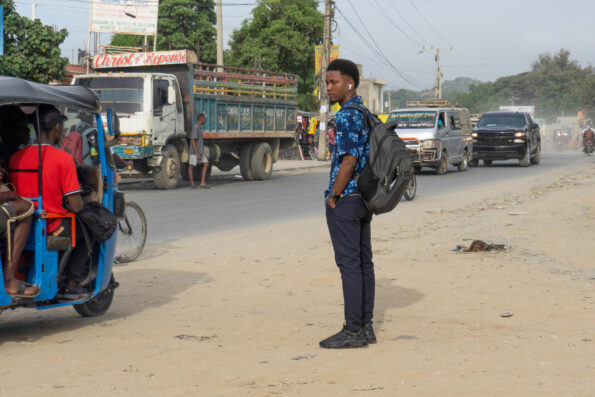
Evidence Chenjerai, GPJ Zimbabwe
Cyclone Idai brought mudslides, boulders and rainfall to the Ngangu area of Chimanimani in March 2019, destroying scores of homes. The storm also demolished roads and bridges, smashed water pipes, and wiped out farmers’ cattle and land.
MUTARE, ZIMBABWE — Before the coronavirus crisis, mornings were usually quiet at the Nyamatanda camp for internally displaced persons. Children were off to school, while many adults sought piecework in the nearby town. Small tents studded the camp, some patched to protect the belongings of the families who called them home.
Nyamatanda is among a group of camps that house 200 families who lost almost everything to Cyclone Idai in 2019. More than a year later, the Zimbabwean government has not relocated them.
And the coronavirus has made this challenging situation more stressful — and dangerous.
Jani Mapise, 70, lives at Nyamatanda with his wife and seven children. They survived on aid from relief agencies, but those groups have pulled back. Now that Zimbabwe has enacted measures to combat the coronavirus, Mapise can’t even leave the camp to look for work.
“I am struggling to make ends meet, being stuck at the camp in our tent all day,” says Mapise, who used to help farmers weed and harvest in return for food and cash, which he added to the aid from nongovernmental organizations.
“The little we hear on the radio is that we need to maintain social distance,’’ he says, “but tell me how is that possible when you are nine in a single small tent?”



Many residents of these camps are from Chimanimani district, 415 kilometers (about 259 miles) southeast of Harare, Zimbabwe’s capital. Other camps in eastern Zimbabwe also house those whose lives were upended by the cyclone.
Cyclone Idai made landfall in southeastern Africa in March 2019, killing some 1,300 people in the region. It caused about $773 million in damage and destroyed more than 100,000 homes.
In Zimbabwe, the storm left an estimated 340 dead and affected 270,000 people throughout the country. About 51,000 were internally displaced.
The cyclone killed at least 169 people in Chimanimani. More than 10,000 residents there were displaced, but most found shelter with relatives. Those now in IDP camps had nowhere to go.
As of December 2019, conflict and human rights violations had displaced nearly 46 million persons in their own country, according to the International Organization for Migration. Each year, another 25 million people on average are displaced due to disasters.
Health experts and relief agencies say IDPs are at high risk for disease in camps, which are often crowded and offer minimal health services. Now the coronavirus, spread through microscopic droplets, has heightened those concerns.
Tents at Nyamatanda should ideally house four people each. They often hold more.
“In their living conditions, guidelines like maintaining social distancing are not possible,” says Dr. Admore Jokwiro, a public health expert who has practiced for 10 years. “So if one of them gets infected, chances of spread within a short time to others are very high.”
As of June 20, Zimbabwe had 479 confirmed cases of COVID-19, the disease caused by the coronavirus, and four deaths. There are no confirmed cases among the IDPs.



Lydia Chidoko, 68, lives at Nyamatanda with her husband and four adult children. She says Cyclone Idai left them with only the clothing they raced to pack just before the storm. They live mainly on aid, including food, clothes and cash from relief groups.
She urges her children to stay inside and reminds them to wash their hands.
“We are told that we need to wash our hands regularly with soap, which is a luxury to someone in my position,” says Chidoko, who does not have money for soap. “Alternatively, we are using ashes from fire to wash our hands and do not know if it is preventative enough to avoid contracting the coronavirus.”
Experts say that hand-washing with soap remains one of the most effective ways to avoid the coronavirus.
Mapise worries that conditions at the camp, where about 30 families live, leave them vulnerable: “We are too many in one camp, where we are expected to share toilets, bathroom and tap for water, which is really worrisome.”
Before the coronavirus crisis, residents used to come and go from Nyamatanda daily. Children attended schools in Chimanimani, and residents used the district’s health centers and grocery stores, and did other business there.
The camp holds people from all stages and walks of life. There are pensioners with large families, like Mapise, and young couples who had moved to Chimanimani to look for work before the cyclone struck. They all hope the government provides housing soon.
Joshua Sacco, member of Parliament for Chimanimani East, says the plight of the IDPs concerns him. He says government officials picked an area to temporarily shelter the IDPs, then decided to resettle them in a place where they can have permanent housing. He does not know when the government will move the IDPs.
Back at Nyamatanda, residents focus on survival. Along with following other government measures against the coronavirus, most now wear masks.
They can buy them for a few dollars in the camp, but many IDPs make their own. Chidoko, for example, stitches them from bath towels. She is not confident they will protect her and her family, but she can’t afford other masks.
The office of the United Nations High Commissioner for Refugees in Zimbabwe says Chidoko’s plight is common for IDPs. Amid the pandemic, many IDPs and refugees have run out of funds for basic groceries and other supplies. They also need better protective gear.
“International support is urgently needed to help step up services both for them and for local communities,” says Olivia Mugambi, a UNHCR protection officer. “This will benefit the health of all.”
Evidence Chenjerai, GPJ, translated some interviews from Shona.







